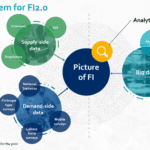Savings-Led Digital Finance: The Dawn of a New Era?
The booming digital lending market surpassed $300 billion in 2020, with significant growth coming from new smartphone users in emerging markets. Every day, millions of clients from Kenya to the Philippines use innovative fintech apps like Tala and Branch to access “instant loans” from their mobile phones. These digital lending apps analyse data extracted from the phones of prospective clients to make data-driven lending decisions without the need for loan officers or brick-and-mortar banks. For aspiring entrepreneurs in the developing world, these digital solutions can provide essential working capital that might otherwise be impossible to obtain from traditional lenders.
Amidst all the success stories, however, are a growing number of concerns about the risky practices some digital lenders use to serve vulnerable clients in developing markets. A 2021 Center for Financial Inclusion blog by Maria Gabriela Coloma Ponce de Leon underscored this challenge, noting that “the primary problem is that digital lenders do not measure the capacity of someone to repay, but their willingness to repay, and these are drastically different concepts.”
In this single sentence, the author focuses our attention on the critical question in digital finance today: How can digital lenders accurately measure the capacity of a client to repay in a low-cost, rapid and ethical manner?
One approach might be to establish the various income-generating roles a client undertakes and assign an earnings estimate to each role using some kind of earnings matrix. Government statistics could theoretically provide some of this information, but many countries do not publish useful earnings data, especially for the informal economy. In developed countries, data from credit bureaus is used to attach a confidence level to a borrower’s stated level of income, but these services are typically not available for most customers in frontier markets.
If estimates based on published data sources aren’t the answer, digital lenders could try to assess income levels directly. Unfortunately, the earnings of different clients vary greatly even within the same roles, either due to time spent, local variations or different levels of entrepreneurship. At best, this might help lenders weed out intentionally misleading loan applications, but collecting this information would create a highly discontinuous and “friction-full” client experience, which also has costs.
Even if digital lenders could generate an accurate earnings estimate, this approach requires another essential piece to the puzzle – understanding a client’s spending patterns. While some clues can be gained from analysing smartphone data, spending patterns are even more variable and harder to predict than income estimates. Add the possibility of compound inaccuracies in this approach, and the question needs to be asked: Is there a better way to assess ability to repay that is economical, universal and reliable?
A New Approach: Saving-led Digital Finance
Part the answer may come from a new generation of “savings-led” digital finance apps that use the savings capacity of clients as a proxy for their ability to repay loans. Unlike “instant credit” apps, which can lead to over-indebtedness, these savings-led solutions start by helping clients build good saving habits. From the lender’s perspective, the primary benefit of this approach is that the clients themselves demonstrate how much surplus they have by how much they save and when. Instead of digital lenders estimating what clients can afford, each client’s track record of savings generates this information straightaway. A second clear benefit of the savings-led approach is that it encourages borrowers to build healthy saving habits, which inevitably builds financial resilience.
Here at DreamStart Labs we offer a group-based savings app called DreamSave that makes it easy for clients in emerging markets to build savings, access loans and achieve financial goals. DreamSave enables members of existing informal savings groups to manage and track their financial activities digitally, and we have now started to link these groups to formal financial service providers. With the permission of clients, we collect data generated by these member-to-member transactions, including internal lending, and by interactions between the group and external lenders. By statistically analysing this information, we generate data-driven credit scores that incorporate predictive relationships between a wide variety of factors, including the ratio of loans-to-internal savings and a member’s repayment performance.
As one might expect, our analysis shows that the higher the loan-to-savings ratio, the higher the probability of loan default. Our threshold analysis for groups in rural Africa, which looks at this variable in isolation, estimates that a loan-to-savings ratio of 1.35:1 best separates borrowers who repay loans on time from those who do not. In other words, group members who borrow $1.35 or less from the group per every $1 they’ve contributed in savings are less likely to pay late or default on their loans.
Another key finding is that the amount saved by a client is typically more important as a predictive indicator than the frequency of savings. Savings success, measured as the amount saved divided by the group maximum, is highly significant in predicting potential default, whereas savings frequency is far less relevant statistically. This finding is evident across different country data sets.
For group-based savings apps, our research suggests that other savings-led transactions are also statistically significant in predicting member loan repayment performance. These transactions include a member’s contributions to the group’s social fund (a separate savings pool for emergency use by members which does not have to be repaid), and fines levied by her group (for transgressions ranging from non-attendance at meetings, to non-contribution to savings and non-payment of loans). Given that these transaction types are entirely outside the scope of credit-led solutions, this is further evidence of the power of savings-led digital finance to measure a borrower’s capacity to repay.
Benefits and Trade-offs of the Savings-led Approach
There are, of course, some potential trade-offs of this approach. From a digital lender’s point of view, savings-led apps require more time to gather relevant data on each client. Instead of generating an instant quote, lenders engage with clients over a period of time, developing a trusted relationship rather than adopting a purely transactional approach. Credit-led digital finance may promise faster revenue growth out of the gate, but it often comes at the cost of putting some clients into debt stress. Savings-led solutions, by contrast, may result in slower growth, but they help clients build healthy financial habits and make it easier for digital lenders to understand each client’s true capacity to repay. In the long term, we believe the savings-led model is more sustainable for all parties.
Most importantly, we see a significant benefit to clients in terms of fair treatment, especially when it comes to the risk of putting borrowers into an unsustainable debt cycle. Savings-led digital lending may not deliver the instant gratification of “sign up and walk away with a loan” on first engagement. But for those willing to wait a little longer, we believe it will prove to be the better approach. Once that trust relationship is established and data starts flowing, the savings-led digital lender is equally able to deliver “instant credit” decisions, just like first-generation credit-led apps – yet with the advantage of superior data and lower risk for all parties.
The emergence of savings-led apps marks an important milestone in digital finance. If these new solutions lead to healthier financial practices for vulnerable clients and better data-driven decisions for fintech lenders – everyone wins.
Editor’s Note: This article was voted by readers as one of NextBillion’s Most Influential Articles of 2022.
Philip Acton is an Advisor, and Finn Tiedemann is a Credit Analyst, at DreamStart Labs Inc.
Photo courtesy of Simon Berger, via Pexels.
- Categories
- Finance, Technology



